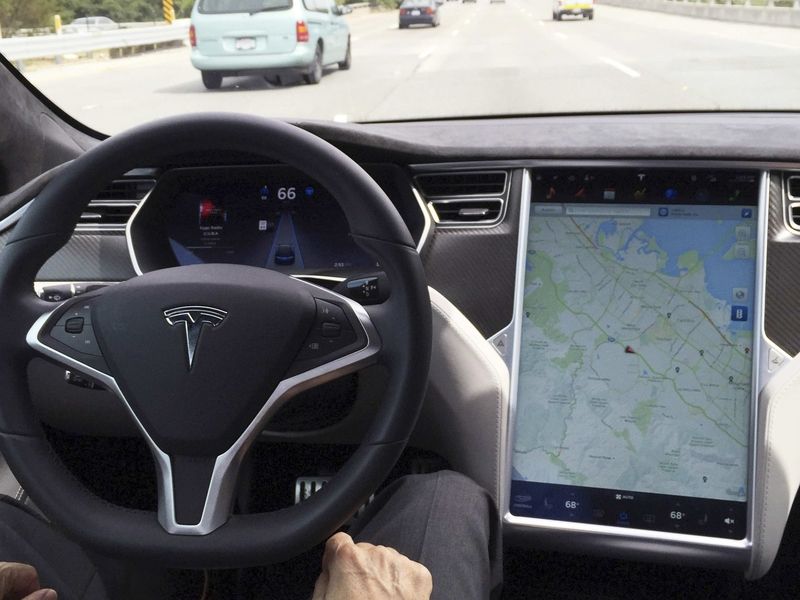
At a time when federal officials are scrutinizing the safety of Tesla Autopilot, new research sheds light on how the system is reshaping driver behavior.
When the driver-assist system is enabled, Tesla drivers’ eyes stray from the road more frequently and for longer periods of time compared with manual driving, according to researchers from the Massachusetts Institute of Technology.
This is believed to be the first study that uses real-world driving data to measure how attentive Autopilot drivers are behind the wheel, and where they’re glancing besides the road ahead.
“This is the first time we can quantify the effects of automation, in this case specifically Tesla Autopilot, on how drivers pay attention,” said Pnina Gershon, MIT research scientist and one of the study’s authors. “Essentially what it shows is when Autopilot is engaged, we see glances off the road that are longer.”
The findings arrive as NHTSA investigates 11 crashes in which Autopilot-enabled vehicles struck stopped emergency vehicles. Tesla has until Oct. 22 to submit a written response and data requested by the federal regulator.
That investigation represents a narrow subset of broader safety concerns with Autopilot. In investigations of multiple fatal crashes involving Autopilot-enabled vehicles, the National Transportation Safety Board has cited inadequate driver monitoring and a lack of safeguards with Autopilot that could thwart foreseeable misuse. Further, the NTSB has warned that such Level 2 automated-driving systems can lead to human overreliance, a condition it calls “automation complacency.”
Tesla-related misuses have been exhaustively cataloged on YouTube, with drivers reading the newspaper or sitting in the rear seats showcasing brazen disregard for the driving task. Autopilot is a driver-assist system that requires a human operator who is responsible for vehicle operations at all times. Tesla’s owner manuals even state that drivers need to keep their hands on the steering wheel at all times.
But not all inattention is so egregious. The MIT researchers sought to quantify levels of attentiveness by analyzing glance patterns during the time in which Tesla drivers manually disengaged the Autopilot system and retook control.
Observing 290 instances of those transitions via in-cabin cameras, researchers distinguished between off-road glances related to the driving task, toward mirrors and the instrument clusters, and glances unrelated to driving, such as those downward and toward the center-stack area. Among the findings: driving-related glances decreased with Autopilot active compared with manual driving. Glances unrelated to driving — those downward and to the center-stack area — were the most frequent, and 22 percent exceed two seconds compared with 4 percent in manual driving.
That two-second threshold is an important one. To prevent distracted driving, NHTSA recommends engineers design systems in a way that ensures motorists do not glance away from the road for more than two seconds. Several nondriving glances in excess of five seconds were detected during the study, Gershon said.
Whether it’s safe for drivers to glance away for longer periods while driver-assist systems handle the driving task is an important question for both Tesla and the rest of the auto industry to consider. The findings indicate it’s time to ask.
“Tesla is redefining the attentional aspects of driving without any regulatory oversight here,” said Bryan Reimer, research scientist in the MIT Center for Transportation and Logistics. “The traditional metric for a long glance away from the road is two seconds, and when you think of this in that context, you say, ‘Wait that’s a big difference.’ Is that OK? Is that not OK? That’s some of the philosophical and societal debate that needs to happen here. This is a big company in California setting transportation policy and making safety decisions for consumers and other road users.”
The study, entitled “A Model For Naturalistic Glance Behavior Around Tesla Autopilot Disengagements,” does not comprehensively catalog what drivers are doing when they glance away for reasons not related to driving, though Gershon says there are anecdotal cases in which drivers were distracted by handheld cellphones.
Future research will analyze the glance patterns of drivers using other popular driver-assist systems. It stems from the Advanced Vehicle Technology Consortium, founded at MIT in 2015 as an industry-academic partnership to study how consumers use — or don’t — the driver-assistance systems already in production vehicles.
Tesla deployed its first iteration of Autopilot in 2015. General Motors launched its Super Cruise driver-assist system in 2017, and since then numerous automakers have followed with ever-more advanced features.
Both the company-specific focus of the latest research and its groundbreaking status suggest, despite the fact these Level 2 systems have been on the road for years, automakers don’t yet know all that much about how drivers use them or how effective some systems are compared with others.
Reimer says he’s concerned about the isolated nature of systems development, and that more needs to be understood about how these systems affect the humans still responsible for the vehicle operations.
“If each OEM continues to go this alone, we’re going to wind up with two cars next to each other on the road that are developed based on foundationally different design philosophies and policy approaches and not working effectively together in an ecosystem,” he said.
“We need to sharpen the knife, and do a better job looking at what’s successful and what’s less successful so what system designers intend carries over to the consumer, and the consumer now has more intuitive information to make some decisions on what they feel is going on around them in the car.”

